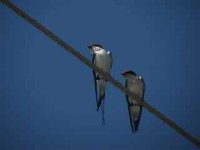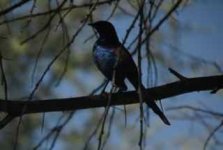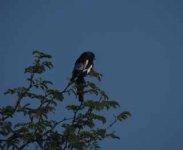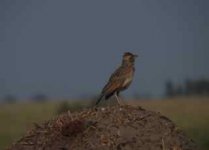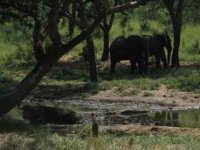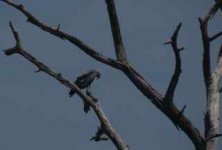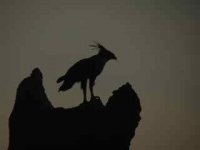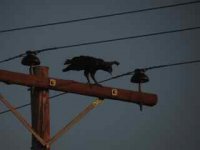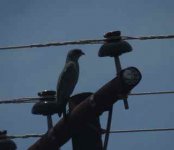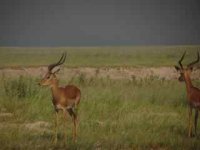Padraig
Well-known member
18.2.15
I spent the day exploring the riverine trees at Drotsky's Cabins and ouside the perimeter.
Birds seen:
Broad Billed Roller, Magpie Shrike, Spotted Flycatcher, White Browed Sparrow Weaver, Willow Warbler, Green Winged Pytilia, Dusky Indigobird, Marico Sunbird, Green backed Heron, Black Crake, Giant Kingfisher, Meve's Starling, Red Billed Francolin and Southern Brown Throated Weaver.
That evening I met a couple who were back from the eastern Highlands of Zimbabwe with lots of interesting stories of the birds they saw there.
I made an arrangement to met them at sun-rise to try and entice a certain bird from the papyrus beds.
At sun-up we sat on a bank of a narrow stream with papyrus on the other side and played a birdsong app (with speakers) of a Greater Samp Warbler. We could see a bird approaching us but only got the flimsiest of views.
In the meanwhile, a Chirping Cisticola began to call and we played that all back. The bird came right into the open in front of us and stayed there for a couple of minutes.
We tried the Swamp Warbler call again, and again the bird came towards us. This time we got two glimpses of the bird in the open, lasting 5 seconds each, before it retreated into the papyrus bed for the last time. 5 seconds can appear like a long time when it comes to warblers.
These were 2 birds I would never have seen on my own, and I was grateful to the couple for sharing it with me.
I also spotted a Crested Barbet overhead in the trees.
Although I was booked into Drotsky's for 4 nights, I decided to leave a day early to get back to Kasane where more birds awaited to be seen.
I thoroughly enjoyed exploring Drotsky's and hanging out with staff especially in the shade in the hot afternoons.
That evening, after a 6 hour drive, I headed to Mowana Lodge, downstream from Kasane and headed towards the Chobe rapids in search of Rock Pratincoles.
The evening was still hot, mosquitos were biting and acacia thorns scratched me as I tried to get downstream while there was still light.
I avoided standing by he river's edge as I had heard some gorey stories of crocodile attacks; there were hippos grunting in the river and I was on the lookout for any that emerged from the water at dusk.
Overall, the experience was slightly nerve-racking and I also failed to see the Pratincoles.
By way of compensation, I saw my first Copper Tailed Coucal.
Other birds I saw were Goliath, Greenbacked Herons, Black and Yellow Billed Egrets.
Back at Mowana Lodge there is a huge Boabab tree (Mowana) which is reportedly 800 years old. There were about 20 Trumpeter Hornbills roosting in the neighbouring trees just outside tourist's windows.
Not a bad sight for those who were paying a princely amount in US dollars to stay there.
Meanwhile I returned to my £10 a night campsite at Chobe Safari Lodge.
More birding tomorrow.
I spent the day exploring the riverine trees at Drotsky's Cabins and ouside the perimeter.
Birds seen:
Broad Billed Roller, Magpie Shrike, Spotted Flycatcher, White Browed Sparrow Weaver, Willow Warbler, Green Winged Pytilia, Dusky Indigobird, Marico Sunbird, Green backed Heron, Black Crake, Giant Kingfisher, Meve's Starling, Red Billed Francolin and Southern Brown Throated Weaver.
That evening I met a couple who were back from the eastern Highlands of Zimbabwe with lots of interesting stories of the birds they saw there.
I made an arrangement to met them at sun-rise to try and entice a certain bird from the papyrus beds.
At sun-up we sat on a bank of a narrow stream with papyrus on the other side and played a birdsong app (with speakers) of a Greater Samp Warbler. We could see a bird approaching us but only got the flimsiest of views.
In the meanwhile, a Chirping Cisticola began to call and we played that all back. The bird came right into the open in front of us and stayed there for a couple of minutes.
We tried the Swamp Warbler call again, and again the bird came towards us. This time we got two glimpses of the bird in the open, lasting 5 seconds each, before it retreated into the papyrus bed for the last time. 5 seconds can appear like a long time when it comes to warblers.
These were 2 birds I would never have seen on my own, and I was grateful to the couple for sharing it with me.
I also spotted a Crested Barbet overhead in the trees.
Although I was booked into Drotsky's for 4 nights, I decided to leave a day early to get back to Kasane where more birds awaited to be seen.
I thoroughly enjoyed exploring Drotsky's and hanging out with staff especially in the shade in the hot afternoons.
That evening, after a 6 hour drive, I headed to Mowana Lodge, downstream from Kasane and headed towards the Chobe rapids in search of Rock Pratincoles.
The evening was still hot, mosquitos were biting and acacia thorns scratched me as I tried to get downstream while there was still light.
I avoided standing by he river's edge as I had heard some gorey stories of crocodile attacks; there were hippos grunting in the river and I was on the lookout for any that emerged from the water at dusk.
Overall, the experience was slightly nerve-racking and I also failed to see the Pratincoles.
By way of compensation, I saw my first Copper Tailed Coucal.
Other birds I saw were Goliath, Greenbacked Herons, Black and Yellow Billed Egrets.
Back at Mowana Lodge there is a huge Boabab tree (Mowana) which is reportedly 800 years old. There were about 20 Trumpeter Hornbills roosting in the neighbouring trees just outside tourist's windows.
Not a bad sight for those who were paying a princely amount in US dollars to stay there.
Meanwhile I returned to my £10 a night campsite at Chobe Safari Lodge.
More birding tomorrow.




